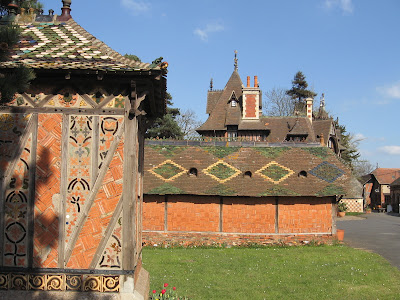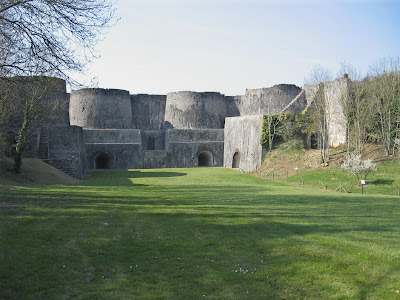It is nearly a week since we set off to face a new series of adventures in Europe, exchanging for a few months the comfort of our house, for the confined space and lack of facilities in Modestine. Such is our addiction to travel that we were only too eager to return to the nomadic lifestyle that became our normal way of living last year.
We've had a very peaceful, happy week so far, being spoilt by friends in England and France. On our way to the ferry port in Portsmouth we spent a couple of nights in Wilton. Our friend Rosemary was singing in a performance of Bach's St. John Passion in a packed Salisbury Cathedral. The following day we enjoyed a pretty spring walk across open fields offering a colourful springtime vista of the Wiltshire Downs.
On Monday, after a sunny picnic together in the New Forest near Brockenhurst we continued to the ferry port leaving our friends to explore the little town and play with the ponies. We crossed on the Mont St. Michel, a new ship on the Portmouth-Caen route that offered such distractions as karaoke and quizzes about pop music plus the opportunity to see (again?) the English film "Déjà vu." Not having seen it before we decided we were not eligible to watch it!
Our time since we have arrived in Caen has been as enjoyable as always - a busy round of seeing friends and revisiting favourite haunts. Most of all we have had time to catch-up on family news and general gossip with Geneviève. We have revisited the Abbaye aux Hommes where the remains of William the Conqueror lie buried, visited several museum exhibitions and enjoyed a supper party, organised by Geneviève in our honour, with our friends Gaston, Odile and Marie-Françoise from the Bibliothèque Municipale in Caen.
The sun has been really bright but the day we decided to visit the chic coastal resorts of Deauville and Trouville, each with its elaborate casino, was icy cold. After a browse around the quayside market and the quaint, paved back streets of the town we were only too happy to warm up in the Trouville museum and town hall investigating exhibitions about French humour (definitely not the same as British) and Normandy architecture of the late 19th century (definitely not the same as British.) We crossed the bridge to the larger resort of Deauville, full of extravagant properties dating from the 1880s, with projecting windows, high pitched roofs and decorative ridge tiles, many set in their own large grounds and facing straight onto the seafront with a distant view of Le Havre across the estuary of the Seine. Returning to Caen we stopped at the artisan tileworks at Bavant where many of the decorative roof tiles and glazed friezes to be seen on the houses of Deauville where originally manufactured. Although now functioning on a smaller scale, glazed roofing tiles, finials and decorative figures used in house decoration are still produced to order. There is also a shop selling anything from glazed terracotta frogs, sheep, geese and cats, to fiery dragons for the roof or a Venus for the lawn.








After that the weather turned warmer and we have been enjoying lunch in the garden. Yesterday this was followed by an afternoon walk through stunning springtime countryside beside a bubbling tributary of the river Orne, where the fields were bright with celandine, anenomies, violets and white nettle while the hedgerows were a haze of bright green buds just beginning to open, interspersed with the white starry blossoms of hawthorn bushes and the bright yellow flowers of the spiky gorse. In the fields the huge brown and white, heavily speckled cattle, typical of Normandy, stood knee deep in the bright green, new, spring grass.

Today Jill took very much a back seat while Ian navigated and Geneviève drove over 200 kilometres on a round trip to La Manche – that part of Normandy that lies towards the boundary with Brittany to the north of Mont St. Michel. Of course we didn't manage to do half the things we wanted but with daylight now lasting until well after 8pm we had no need to rush home. We passed near the town of Coutances and stopped to explore the coast at the estuary of the river Sienne. Way out to sea we could just discern the French owned Îles Chaussées which lie to the south of the British Channel Islands. Here the sandy mudflats stretched to the sea and the shoreline was a waving mass of marram grass and salt-marches, grazed by sheep. Apparently such pasture produces richly flavoured meat known as "pré-salé". Having driven through a typically Normandy countryside with its white stone houses and lichen-covered orange roof tiles, its orchards and hedgerows, it came as a surprise to discover this coastal area was more like Brittany than Normandy, even to the style of architecture with slate roofs and granite starting to appear as a building material. The main difference was that the white sandy beaches lacked the chaos of giant granite boulders to be seen all along the north coast of Brittany.

We sat amongst the sand dunes, sheltered from the sea breeze, with mugs of tea and baguettes of French cheese and ham before investigating the church in the village of Regnéville. Here the aged priest engaged us in a long conversation ranging from memories of his English penfriend in his youth, to the problems of observing the Easter practice of removing the lamp from the altar on Good Friday when one priest now has to attend to several different churches around the parish. He explained the reason the tower looked odd was because the spire had collapsed around the time of the French Revolution. It is still lying where it fell beside the church wall.


Working off lunch we walked inland from the sea to discover a massive series of four lime kilns constructed in the 1850s – Les Fours à Chaux du Rey. The limestone was quarried on site, coal was imported from Cardiff to the little port at Regnéville and the kilns kept in permanent use for eight months of every year until the 1880s. The lime was shovelled out at the base of the kilns once the carbon content had been burned off. It was then crushed and used for a variety of uses in agriculture and chemical and pharmaceutical products. Each kiln produced 27 tons of lime each day.

We returned to Caen via the 12th century Benedictine Abbaye de Hambye, Normandy's answer to Tintern Abbey. We had planned to visit it properly but ran out of time and found it closed when we arrived. It stands as a charming ruin in a beautiful rural setting where cattle graze the pale primroses of the grassy banks that surround it.


Saturday 7th April 2007, Caen
Today was market day in Bayeux and we had arranged to meet Chantal and her two Vietnamese children for a browse around the stalls selling everything from live crabs and oysters to live rabbits, chickens, ducks and geese. The sun shone and it was a splendid, crisp morning. Maybe it is because of the Easter holidays, or maybe the Brits are discovering the beauty of Normandy, but there seemed almost as many English voices around the market as French ones. On one market stall we discovered Geneviève's brother-in-law selling organic herbs grown in the garden of his home out in the countryside nearby. It is several years since we last saw him so it was an agreeable surprise.
Having made our purchases of vegetables for tomorrow's Easter day lunch, we returned with Chantal to see the progress on the late 18th century house she is restoring in the centre of the old town of Bayeux. It looks to us as if she still has years of work ahead of her but she remains confident of having it ready within six months. Certainly the situation and potential are excellent but the work would quite daunt us.


We drove together the 20 kilometres through the narrow, deserted lanes of the Normany countryside back to Chantal's present house, a converted school and mairie beside the village churchyard at Torteval. This too she has completely renovated but there still remains much to do. It is beautifully set with a lake and a small chateau with pointed towers nearby - the only neighbours. Lunch took rather a long time as we all sat around the sunny table enjoying large bowls of home-made spaghetti with salad, a bottle of Touraine wine, camembert, a sticky apple tarte tatin and a dish of thick unpasteurised cream, fresh from the farm.



In the evening we had an invitation for supper with Benedicte, another friend on the staff of Caen Library responsible for the electronic and digital services. She, poor lass, still has several years before retirement and will be the last of our colleagues still working once Odile and Gaston retire. We spent a very enjoyable evening moaning together about permanent restructuring, internal politics and the way the bibliographic wheel seems to turn full circle every decade as the same ideas are rediscovered by a new generation.
Supper of course was superb. We keep referring to the food because our hosts have gone to such lengths to ensure we enjoy our time here to the maximum, our readers tell us they enjoy reading about the food and we certainly enjoy doing full justice to it! The evening started with an "apéro" of kir and olives, continued with a refreshing hors d'oeuvre of tomato salad with palm kernels, pink grapefruit and black olives. The main course was duck with roast potatoes, mushrooms and green salad followed by a plate of French cheeses. All was accompanied by a red Touraine wine from Chinon. We finished with an almond tart and a tisane or fruit tea. (In France coffee is rarely drunk at the end of a meal.) It was after midnight before we left the supper table and toddled our way home.
